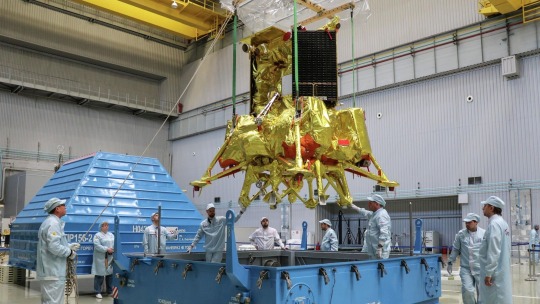#Luna-25 lander
Text

These before and after photos taken by NASA's moon orbiter reveal the crash site of Vladimir Putin's failed Russian lunar lander. It slammed into the moon Aug.19, 2023, leaving a crater about 33ft (10m) wide. The probe was demolished on impact causing significant injury to Putin's ego.
#moon#Putin#Russia#lunar lander#luna-25#science#astronomy#space#outer space#aesthetic#politics#landscape#Simpsons#Nelson#haha#funny#lol#beauty-funny-trippy#Vladimir Putin#Russian#crash
92 notes
·
View notes
Text
India's Lunar Mission Captures Images of Far Side of the Moon Ahead of Historic Landing
Image: ISRO
Chandrayaan-3 is India’s second attempt to land on the Moon. The first attempt didn’t go so well: Chandrayaan-2 crashed on the Moon in September 2019 due to an issue with its braking thrusters.
Chandrayaan-2 included a lander-rover duo, as well as an orbiter. The space agency lost contact with the Vikram lander when it was around 1.3 miles (2.1 kilometers) from the lunar surface,…

View On WordPress
#Chandrayaan programme#Chandrayaan-2#Chandrayaan-3#Gizmodo#In India#In spaceflight#Indian lunar exploration programme#Internet#Lander#Luna 25#Lunar lander#Lunar rovers#Lunar south pole#Moon#Moon landing#Technology#the Moon#Vikram
2 notes
·
View notes
Text

CNN — Japan’s “Moon Sniper” robotic explorer landed on the lunar surface, but the mission may end prematurely since the spacecraft’s solar cell is not generating electricity, the Japan Aerospace Exploration Agency said.
The agency said it is currently receiving a signal from the lander, which is communicating as expected.
The uncrewed Smart Lander for Investigating Moon, or SLIM, mission landed just after 10:20 a.m. ET Friday (12:20 a.m. Saturday Japan Standard Time), according to telemetry data shared on JAXA’s live broadcast.
Currently, the lander is operating on limited battery power, only expected to last several hours.
The JAXA team is analyzing the data to determine the cause of the solar cell issue and the next steps for the lander.
It’s possible that the solar cell issue is due to the fact that the spacecraft is not pointing in the intended direction, JAXA officials said.
There is hope that as the solar angle changes on the moon, the solar cell may be able to charge again, but that may take some time and will depend on whether SLIM can survive the frigid lunar night, the team shared during a news conference.
The agency believes the mission has met the criteria to declare it a “minimum success,” because the spacecraft achieved a precise and soft lunar landing using optical navigation.
The touchdown makes Japan the third country this century — and the fifth ever — to land on the moon.
When asked to score the landing operation for SLIM, JAXA director general Dr. Hitoshi Kuninaka gave it a “60 out of 100,” while also mentioning that he is known for making “harsh comments.”
The team is also working to gather all of the scientific data obtained by the lander.

The lander was able to release its two lunar rovers, LEV-1 and LEV-2.
The LEV-1 rover moves using a hopping mechanism and is equipped with wide-angle visible light cameras, scientific equipment, and antennas that allow it to communicate with Earth.
And LEV-2, also outfitted with cameras, can change shape to move across the lunar surface.
The team is receiving a signal from LEV-1 and will see whether its cameras were able to capture any images.
JAXA officials said they will not definitively confirm the status of LEV-2 until more data is received.
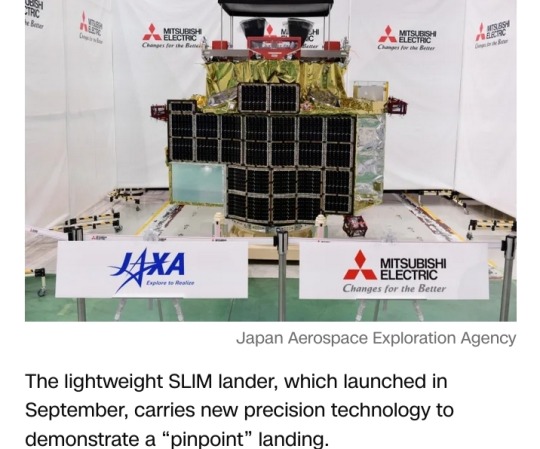
The small-scale SLIM robotic explorer, which launched in September, goes by the nickname “Moon Sniper” because it carried new precision technology to demonstrate a “pinpoint” landing.
Previous lunar missions have been able to target and reach specific zones that spanned many kilometers, but the SLIM lander targeted a landing site that stretches just 100 meters (328 feet) across.
The lander’s “smart eyes” — an image-matching-based navigation technology — rapidly photographed the sloped lunar surface on approach and autonomously made adjustments as the spacecraft descended toward touchdown.
The JAXA team is still working to determine the accuracy of SLIM’s landing, which could take up to a month.
Moon Sniper’s journey
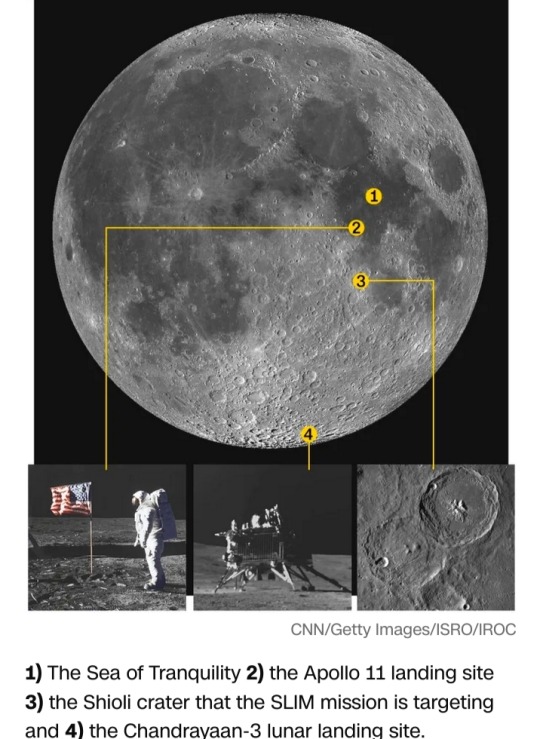
The Moon Sniper targeted a landing site near the small Shioli crater within a lunar plain called the Sea of Nectar that was created by ancient volcanic activity and lies just south of the Sea of Tranquility, where Apollo 11 landed in 1969.
The lander is designed to briefly study rocks at the site that could reveal insights into the moon’s origin.
When meteorites and other objects strike the moon, they create craters as well as rocky debris that litters the surface.
These rocks intrigue scientists because studying them is effectively like peering inside the moon itself.
Minerals and other aspects of the rocks’ composition can potentially shed more light on how the moon formed.
Landing near the sloped, rock-strewn areas around craters is a hazardous process that most missions usually avoid, but JAXA believes its lander has the technology to touch down safely on rocky terrain.
New space race

Multiple space agencies and countries have attempted moon landing missions over the past year, leading to a historic first as well as failures.
India became the fourth country — after the United States, the former Soviet Union and China — to execute a controlled landing on the moon when its Chandrayaan-3 mission arrived near the lunar south pole in August.
Meanwhile, Japanese company Ispace’s Hakuto-R lunar lander fell 3 miles (4.8 kilometers) before crashing into the moon during a landing attempt in April.
Russia’s Luna-25 also crash-landed in August during the country’s first attempt to return to the moon since the Soviet Union’s fall.
Astrobotic Technology’s Peregrine spacecraft — the first US lunar lander to launch in five decades — met a fiery end Thursday after a critical fuel leak made safely landing on the moon out of the question.
Part of the motivation behind the new lunar space race is a desire to access water trapped as ice in permanently shadowed regions at the lunar south pole.
It could be used for drinking water or fuel as humanity pushes the bounds of space exploration in the future.
This region is riddled with craters and strewn with rocks, leading to narrow landing sites.
The lightweight SLIM lander might be an effective design that could not only land in small areas of interest on the moon but also on planets such as Mars, according to JAXA.

#Moon Sniper#robotic explorer#moon#Japan Aerospace Exploration Agency#Japan#Smart Lander for Investigating Moon#SLIM#Dr. Hitoshi Kuninaka#LEV-1#LEV-2#lunar rovers#Sea of Nectar#Sea of Tranquility#Chandrayaan-3#Hakuto-R#Luna-25#Peregrine spacecraft#JAXA#space#space agencies
0 notes
Text
Russia's first moon lander in 47 years has crashed into the lunar surface, the country's space agency reported on Sunday (Aug. 20).
The Luna-25 lander, which Russia had hoped would land at the south pole of the moon as early as Monday (Aug. 21), crashed into the moon after an orbital maneuver went wrong yesterday (Aug. 19), officials with Russia's Roscosmos space agency said.
"At about 14:57 Moscow time [on Aug. 19], communication with the Luna-25 spacecraft was interrupted," Roscosmos wrote in an update on Telegram today (in Russian; translation by Google). "The measures taken on August 19 and 20 to search for the device and get into contact with it did not produce any results."
Continue Reading.
64 notes
·
View notes
Text

Yes, Russia is using old tires to protect its strategic bombers from Ukrainian drones.
Russia is covering aircraft with car tires, potentially to protect them from Ukrainian drones
This is the same sort of technology that gave us the recent Luna-25 lunar lander. 😝
All Ukraine has to do is use infrared cameras – if they're even really needed. The burning tires will only make the fires harder to put out.
If the Russians ever need to use those planes in a hurry, they're going to fall behind schedule by having to remove those tires.
#bart van leeuwen#invasion of ukraine#russia#ukrainian drones#use of car tires as camouflage#tu-95 strategic bombers#tu-160#engels-2#агрессивная война россии#автомобильные шины#камуфляж#бпла#ту-95#энгельс-2#владимир путин#путин хуйло#россия проигрывает войну#союз постсоветских клептократических ватников#руки прочь от украины!#геть з україни#україна переможе#росія - це знущання#вторгнення оркостану в україну#слава україні!#героям слава!
3 notes
·
View notes
Text
New Russian lunar lander Luna 25 has crashed into the Moon after a failed orbit-lowering manoeuvre.
3 notes
·
View notes
Text
A Russian robotic spacecraft that was headed to the lunar surface has crashed into the moon, Russia’s space agency said on Sunday, citing the results of a preliminary investigation a day after it lost contact with the vehicle.
Russian embezzlement has claimed another
When missions are lost during orbital engine firings, the cause often turns out to be shoddy manufacturing and inadequate testing. Those shortcomings were the basis for the failure of Russia’s last major robotic interplanetary probe, Phobos-Grunt, in 2011.
4 notes
·
View notes
Text

The Russian space agency Roscosmos has confirmed that its Luna 25 lander crashed on the Moon following an anomaly in one of the maneuvers that was supposed to lead to its Moon landing on Monday. The problems began on Saturday, when there was the problem and communications were lost. An examination of the telemetry data received up to that point led to the conclusion that the impulse was excessive, leading to a trajectory that caused a crash. Yet another problem in the Russian space program will bring consequences yet to be assessed in the Luna-Glob program which is based on increasingly ambitious missions for the next few years and had already accumulated years of delay.
3 notes
·
View notes
Text
INDIA HAS JOINED THE MOON CLUB LETS GOOOOO
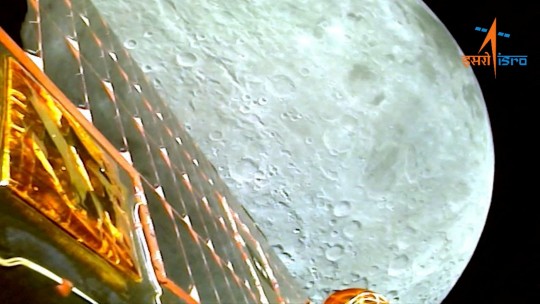
India has landed its Chandrayaan-3 spacecraft on the moon, becoming only the fourth nation ever to accomplish such a feat.
The mission could cement India’s status as a global superpower in space. Previously, only the United States, China and the former Soviet Union have completed soft landings on the lunar surface.
Chandrayaan-3’s landing site is also closer to the moon’s south pole than any other spacecraft in history has ventured. The south pole region is considered an area of key scientific and strategic interest for spacefaring nations, as scientists believe the region to be home to water ice deposits.
The water, frozen in shadowy craters, could be converted into rocket fuel or even drinking water for future crewed missions
Indian Prime Minister Narendra Modi, currently in South Africa for the BRICS Summit, watched the landing virtually and shared broadcasted remarks on the livestream.
“On this joyous occasion…I would like to address all the people of the world,” he said. “India’s successful moon mission is not just India’s alone. This is a year in which the world is witnessing India’s G20 presidency. Our approach of one Earth, one family, one future is resonating across the globe.
“This human-centric approach that we present and we represent has been welcome universally. Our moon mission is also based on the same human-centric approach,” Modi added. “Therefore, this success belongs to all of humanity, and it will help moon missions by other countries in the future.”
India’s attempt to land its spacecraft near the lunar south pole comes just days after another nation’s failed attempt to do the same. Russia’s Luna 25 spacecraft crashed into the moon on August 19 after its engines misfired, ending the country’s first lunar landing attempt in 47 years.
Chandrayaan-3’s journey
As Chandrayaan-3 approached the moon, its cameras captured photographs, including one taken on August 20 that India’s space agency shared Tuesday. The image offers a close-up of the moon’s dusty gray terrain.
India’s lunar lander consists of three parts: a lander, rover and propulsion module, which provided the spacecraft all the thrust required to traverse the 384,400-kilometer (238,855-mile) void between the moon and Earth.
The lander, called Vikram, completed the precision maneuvers required to make a soft touchdown on the lunar surface after it was ejected from the propulsion module. Tucked inside is Pragyan, a small, six-wheeled rover that will deploy from the lander by rolling down a ramp.
Vikram used its on board thrusters to carefully orient itself as it approached the lunar surface, and it slowly throttled down its engines for a touchdown just after 6 p.m. IST (8:30 a.m. ET) as applause erupted from the mission control room.
The Indian Space Research Organization, or ISRO, later confirmed it had established two-way communication with the spacecraft and shared the first images of the surface captured during the lander’s final descent.
The lander, which weighs about 1,700 kilograms (3,748 pounds), and 26-kilogram (57.3-pound) rover are packed with scientific instruments, prepared to capture data to help researchers analyze the lunar surface and deliver fresh insights into its composition.
Dr. Angela Marusiak, an assistant research professor at the University of Arizona’s Lunar and Planetary Laboratory, said she’s particularly excited that the lunar lander includes a seismometer that will attempt to detect quakes within the moon’s interior.
Studying how the moon’s inner layers move could be key information for future endeavors on the lunar surface, Marusiak said.
“You want to make sure that any potential seismic activity wouldn’t endanger any astronauts,” Marusiak said. “Or, if we were to build structures on the moon, that they would be safe from any seismic activity.”
The lander and rover are expected to function for about two weeks on the moon’s surface. The propulsion module will remain in orbit, serving as a relay point for beaming data back to Earth.
2 notes
·
View notes
Text
2023 Space and Astronomy News: What to Expect
https://sciencespies.com/space/2023-space-and-astronomy-news-what-to-expect/
2023 Space and Astronomy News: What to Expect

As years in space and astronomy go, 2022 is going to be a tough act to follow.
NASA wowed us with cosmic scenes captured by the James Webb Space Telescope. The DART mission slammed an asteroid into a new orbit. Artemis I set humanity on a course back to the moon. China finished building a new space station in orbit. SpaceX launched 61 rockets in 12 months. And the invasion of Ukraine imperiled Russia’s status as a space power.
It’s a lot to measure up to, but 2023 is bound to have some excitement on the launchpad, the lunar surface and in the sky. Once again, you can get updates on your personal digital calendar by signing up for The New York Times’s Space and Astronomy Calendar. Here are some of the major events you can expect. Not all of them have certain dates yet, but Times journalists will provide additional information as it emerges. Learn more at nytimes.com/spacecalendar
New Rockets
NASA got its giant Space Launch System off the ground for the first time in 2022, lighting up the night in Florida with an incredible stream of flame as it carried the Artemis I mission toward the moon. That shifted attention to SpaceX, which is building a next generation rocket, Starship, that is also central to NASA’s crewed Artemis III moon landing attempt.
SpaceX cleared a key environmental review that would allow it to launch an uncrewed orbital test flight from South Texas if it met certain conditions. But the rocket wasn’t ready for flight in 2022. The company has not announced a date for a test this year, but regular ground tests of Starship equipment indicate it is working toward one.
The pathfinder first stage of the Vulcan Centaur, a new rocket by United Launch Alliance that will eventually replace that company’s Atlas V.United Launch Alliance
Numerous other rockets may take flight for the first time in 2023. The most important, Vulcan Centaur by United Launch Alliance, will eventually replace that company’s Atlas V, a vehicle that has been central to American spaceflight for two decades. The Vulcan relies on the BE-4 engine built by Blue Origin, the rocket company founded by Jeff Bezos. The same engine will in turn be used in Blue Origin’s New Glenn rocket, which may have a test flight late this year.
A number of American private companies are expected to test new rockets in 2023, including Relativity and ABL. They could be joined by foreign rocket makers, including Mitsubishi Heavy Industries which could test Japan’s H3 rocket in February, and Arianespace, which is working toward a test flight of Europe’s Ariane 6 rocket.
New Lunar Landings
We’re guaranteed at least one lunar landing attempt in 2023. A Japanese company, Ispace, launched its M1 mission on a SpaceX rocket in December. It’s taking a slow, fuel-efficient route to the moon and is set to arrive in April, when it will try to deploy a rover built by the United Arab Emirates, a robot built by Japan’s space agency, JAXA, as well as other payloads.
There could be as many as five more lunar landing attempts this year.
NASA has hired a pair of private companies to carry payloads to the lunar surface. Both of them, Intuitive Machines of Houston and Astrobotic Technology of Pittsburgh, faced delays in 2022, but may make the trip in the coming months.
They could be joined by three government space programs’ lunar missions. India’s Chandrayaan-3 mission was delayed last year but could be ready in 2023. A Japanese mission, Smart Lander for Investigating Moon, or SLIM, aims to test the country’s lunar landing technologies. Finally, Russia’s Luna-25 mission was postponed from last September, but Roscosmos, the Russian space agency, may try this year.
New Space Telescopes
Scientists in 2019 at work with the European Space Agency’s Euclid spacecraft, which will study energy and dark matter. Its 2022 launch was postponed by the Russian invasion of Ukraine.S. Corvaja/European Space Agency
The Webb telescope wowed space enthusiasts and scientists with its views of the cosmos, but we may get new vantages from a variety of orbital observatories.
The most significant may be Xuntian, a Chinese mission setting off later in the year that will be like a more sophisticated version of the Hubble Space Telescope. The spacecraft will survey the universe at optical and ultraviolet wavelengths in an orbit around Earth close to the country’s Tiangong space station.
A Japanese-led mission, XRISM, pronounced chrism, could launch earlier in the year as well. The mission will use X-ray spectroscopy to study clouds of plasma, which could help to explain the universe’s composition. A European space telescope, Euclid, may also launch on a SpaceX rocket after the Russian invasion of Ukraine resulted in the spacecraft losing its seat on a Russian Soyuz rocket. It will study the universe’s dark energy and dark matter.
New Planetary Missions
A new spacecraft will head toward Jupiter this year, aiming to become the first to ever orbit another planet’s moon. The European Space Agency’s Jupiter Icy Moon Explorer, or JUICE, will launch from an Ariane 5 rocket as early as April 5 to set off to the Jovian system, arriving in 2031. Once it reaches the gas giant, it will move to conduct 35 flybys of three of the giant world’s moons: Callisto, Europa and Ganymede, all of which are believed to have subsurface oceans. In 2034, JUICE will begin orbiting Ganymede, the largest moon in the solar system.
Heading closer to the sun will be Rocket Lab, a small launch company that was founded in New Zealand. It aims to use its Electron rocket to send a mission to Venus. The company’s Photon satellite will try to deploy a small probe, built with Massachusetts Institute of Technology researchers, that will briefly study the planet’s toxic atmosphere. The mission was planned for May, but it is expected to face delays while the company prioritizes missions for its other customers.
A Total Eclipse and a Not-So-Total One
There will be two solar eclipses in 2023.
A total eclipse on April 20 will be more of a Southern Hemisphere event, and the moon will only blot out the sun in remote parts of Australia and Indonesia. (Perhaps not a bad time to be on a boat in parts of the Indian and Pacific Oceans, too.)
But Americans may get a good show on Oct. 14, when North America will be visited by an annular eclipse. Eclipses of this type are sometimes called “ring of fire” eclipses because the moon is too far from Earth to fully block the sun but creates a ring-like effect when it reaches totality. The eclipse’s path runs through parts of Oregon, California, Nevada, Utah, Arizona, New Mexico and Texas before dipping into Central and South America. Where the weather cooperates, it should be a great solar show and a nice lead up for the April 8, 2024 total eclipse that will cross the United States from southwest to northeast.
#Space
3 notes
·
View notes
Text
India's Lunar Mission Captures Images of Far Side of the Moon Ahead of Historic Landing
Image: ISRO
Chandrayaan-3 is India’s second attempt to land on the Moon. The first attempt didn’t go so well: Chandrayaan-2 crashed on the Moon in September 2019 due to an issue with its braking thrusters.
Chandrayaan-2 included a lander-rover duo, as well as an orbiter. The space agency lost contact with the Vikram lander when it was around 1.3 miles (2.1 kilometers) from the lunar surface,…
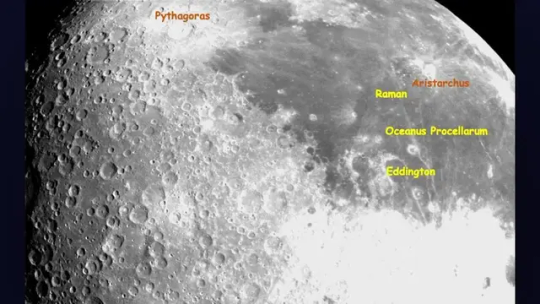
View On WordPress
#Chandrayaan programme#Chandrayaan-2#Chandrayaan-3#Gizmodo#In India#In spaceflight#Indian lunar exploration programme#Internet#Lander#Luna 25#Lunar lander#Lunar rovers#Lunar south pole#Moon#Moon landing#Technology#the Moon#Vikram
1 note
·
View note
Text
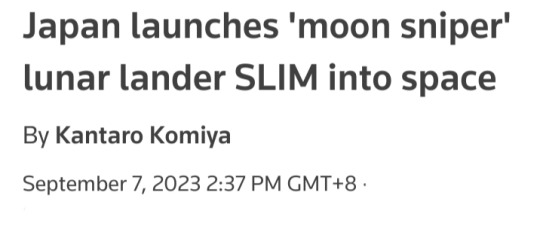

TOKYO, Sept 7 (Reuters) - Japan launched its lunar exploration spacecraft on Thursday aboard a homegrown H-IIA rocket, hoping to become the world's fifth country to land on the moon early next year.
Japan Aerospace Exploration Agency (JAXA) said the rocket took off from Tanegashima Space Center in southern Japan as planned and successfully released the Smart Lander for Investigating Moon (SLIM).
Unfavourable weather led to three postponements in a week last month.
Dubbed the "moon sniper," Japan aims to land SLIM within 100 metres of its target site on the lunar surface.
The $100-million mission is expected to start the landing by February after a long, fuel-efficient approach trajectory.
"The big objective of SLIM is to prove the high-accuracy landing ... to achieve 'landing where we want' on the lunar surface, rather than 'landing where we can'," JAXA President Hiroshi Yamakawa told a news conference.

The launch comes two weeks after India became the fourth nation to successfully land a spacecraft on the moon with its Chandrayaan-3 mission to the unexplored lunar south pole.
Around the same time, Russia's Luna-25 lander crashed while approaching the moon.
Two earlier lunar landing attempts by Japan failed in the last year.
JAXA lost contact with the OMOTENASHI lander and scrubbed an attempted landing in November.
The Hakuto-R Mission 1 lander, made by Japanese startup ispace (9348.T), crashed in April as it attempted to descend to the lunar surface.
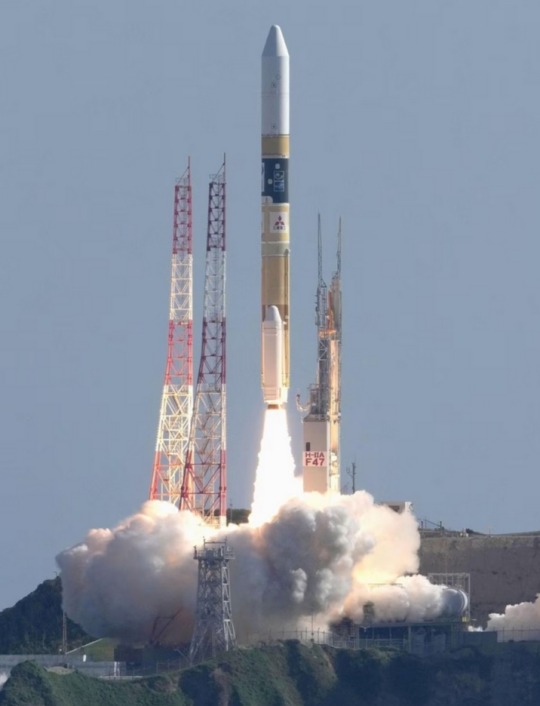
SLIM is set to touch down on the near side of the moon close to Mare Nectaris, a lunar sea that, viewed from Earth, appears as a dark spot.
Its primary goal is to test advanced optical and image processing technology.
After landing, the craft aims to analyse the composition of olivine rocks near the sites in search of clues about the origin of the moon. No lunar rover is loaded on SLIM.
Thursday's H-IIA rocket also carried the X-Ray Imaging and Spectroscopy Mission (XRISM) satellite, a joint project of JAXA, NASA and the European Space Agency.
The satellite aims to observe plasma winds flowing through the universe that scientists see as key to helping understand the evolution of stars and galaxies.

Mitsubishi Heavy Industries (7011.T) manufactured the rocket and operated the launch, which marked the 47th H-IIA rocket Japan has launched since 2001, bringing the vehicle's success rate close to 98%.
JAXA had suspended the launch of H-IIA carrying SLIM for several months while it investigated the failure of its new medium-lift H3 rocket during its debut in March.
Japan's space missions have faced other recent setbacks, with the launch failure of the Epsilon small rocket in October 2022, followed by an engine explosion during a test in July.
The country aims to send an astronaut to the moon's surface in the latter half of the 2020s as part of NASA's Artemis programme.
https://www.reuters.com/technology/space/japan-launches-rocket-carrying-moon-lander-slim-after-three-delays-2023-09-06/
youtube
Japan launches 'Moon Sniper' mission | AFP
7 September 2023
Japan's "Moon Sniper" mission blasted off Thursday as the country's space programme looks to bounce back from a string of recent mishaps, weeks after India's historic lunar triumph.
#H-IIA rocket#Japan#lunar exploration spacecraft#SLIM#moon sniper#Japan Aerospace Exploration Agency (JAXA)#Tanegashima Space Center#Smart Lander for Investigating Moon#Hiroshi Yamakawa#Hakuto-R Mission 1 lander#ispace#Mare Nectaris#X-Ray Imaging and Spectroscopy Mission (XRISM) satellite#JAXA#NASA#European Space Agency#Mitsubishi Heavy Industries#Artemis#space#space rocket#Youtube#Chandrayaan-3 mission#Luna-25 lander#India#Russia#moon#moon landing
22 notes
·
View notes
Text
Russia reignited its moon exploration program today (Aug. 10), sending a lander toward Earth's nearest neighbor.
The Luna-25 mission lifted off today at 7:10 p.m. EDT (2310 GMT) atop a Soyuz-2.1b rocket from the Vostochny Cosmodrome in Russia's far eastern Amur Region. The launch picked up where the former Soviet Union left off in 1976, when Luna-24 successfully delivered about 6.2 ounces (170 grams) of moon samples to Earth.
But that was then. Luna-25 is the first domestically produced moon probe in modern Russian history.
If all goes according to plan, Luna-25 will spend the next five days journeying to the moon, then circle the natural satellite for another five to seven days. The spacecraft will then set down in the moon's south polar region, near Boguslawsky Crater. (Two backup landing spots are also in play: southwest of Manzini Crater and south of Pentland A Crater.)
Once down safe and sound, Luna-25 will work on the lunar surface for at least one Earth year.
Continue Reading.
40 notes
·
View notes
Text
The Indian Space Agency published and almost immediately deleted a photo of its station on the Moon
What secrets are they hiding there?

The Indian Space Research Organization (ISRO) showed a photo of the successfully landing vehicle of the Chandrayaan-3 mission from Earth satellite orbit, but soon deleted it. This caused a lot of speculation among netizens, especially since ISRO did not explain the hasty deletion of the unique image.
"The Chandrayaan-2 orbiter's high-resolution camera currently has the best resolution of any around the Moon," ISRO captioned the image.
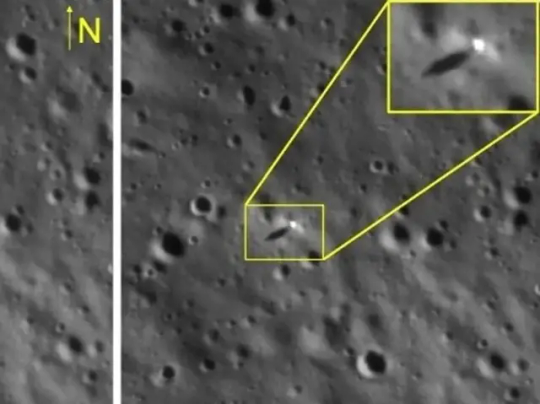
The photo was deleted a few minutes after publication, but many people, including journalists, managed to copy it
Netizens began to wonder why ISRO hid the photo of the descent module on the Moon: was it a publication that was not approved by management, or was the space agency afraid that people would see something secret in the photo?
Meanwhile, Photoshop enthusiasts decided to answer these questions by creating pictures full of stereotypes about Indians.
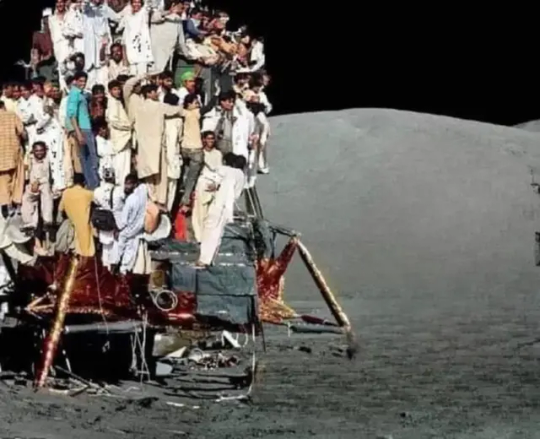
Some believe that on the Vikram lander, if you look closely, you can see passengers who confused the train with a spacecraft.
Jokes aside, Chandrayaan-3 is safe and sound and will soon begin exploring the South Pole of the Moon, where spacecraft from other countries have not yet landed on the Moon.

Or hiding a cow
Let us recall that the successful landing of the Vikram lander on the lunar surface took place on Wednesday , August 23. And this date will go down in the history of Indian space exploration: India has now officially become the fourth “lunar power” after the USSR, USA and China.
The first lunar mission, Chandrayaan-1, was launched into lunar orbit in November 2008. It did not involve landing - the automatic station worked in orbit around the Earth’s satellite for a year and a half and ceased to exist. On July 22, 2019, ISRO sent Chandrayaan-2 to the Moon with a landing module, but the device crashed while attempting to land. At the same time, the Chandrayaan-2 orbital station continues to operate in lunar orbit and sends pictures to Earth; it was from it that photographs of the landing module of the Chandrayaan-3 mission were taken.

And perhaps a dance duet
Let us add that the Russian state corporation Roscosmos, after the failure with the Luna-25 spacecraft, plans to launch the next automatic station to the Moon a year or two earlier than planned. The head of the corporation, Yuri Borisov, urged not to make a tragedy out of the crash of Luna-25 and to continue working. him According to , during a working meeting at NPO Lavochkina, it was decided that Luna-26 would go to the Earth’s satellite in 2025-2026. Previously, the launch of this device was planned for 2027.

According to the Americans, this is what the Indian lunar rover looks like, which they decided not to show for the time being.
#The Indian Space Agency published and almost immediately deleted a photo of its station on the Moon
1 note
·
View note
Text
La sonda giapponese Slim atterra con successo sulla Luna
Il Giappone è il quinto paese al mondo a toccare il suolo lunare. Lo Smart Lander for Investigating Moon è arivato a 55 metri dall’obiettivo
Danilo Di Mita 25 gennaio 2024
AFP – La sonda giapponese Slim al momento del lancio nello spazio
spazio luna giappone
1 min di lettura
source
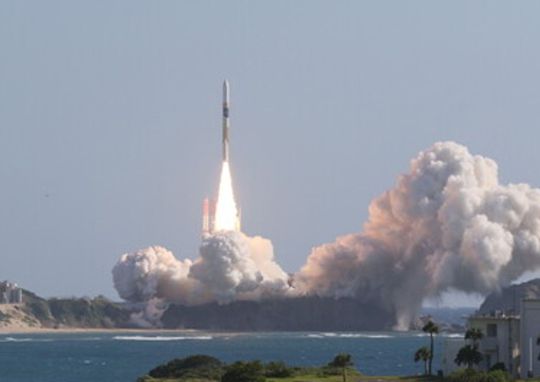
View On WordPress
0 notes
